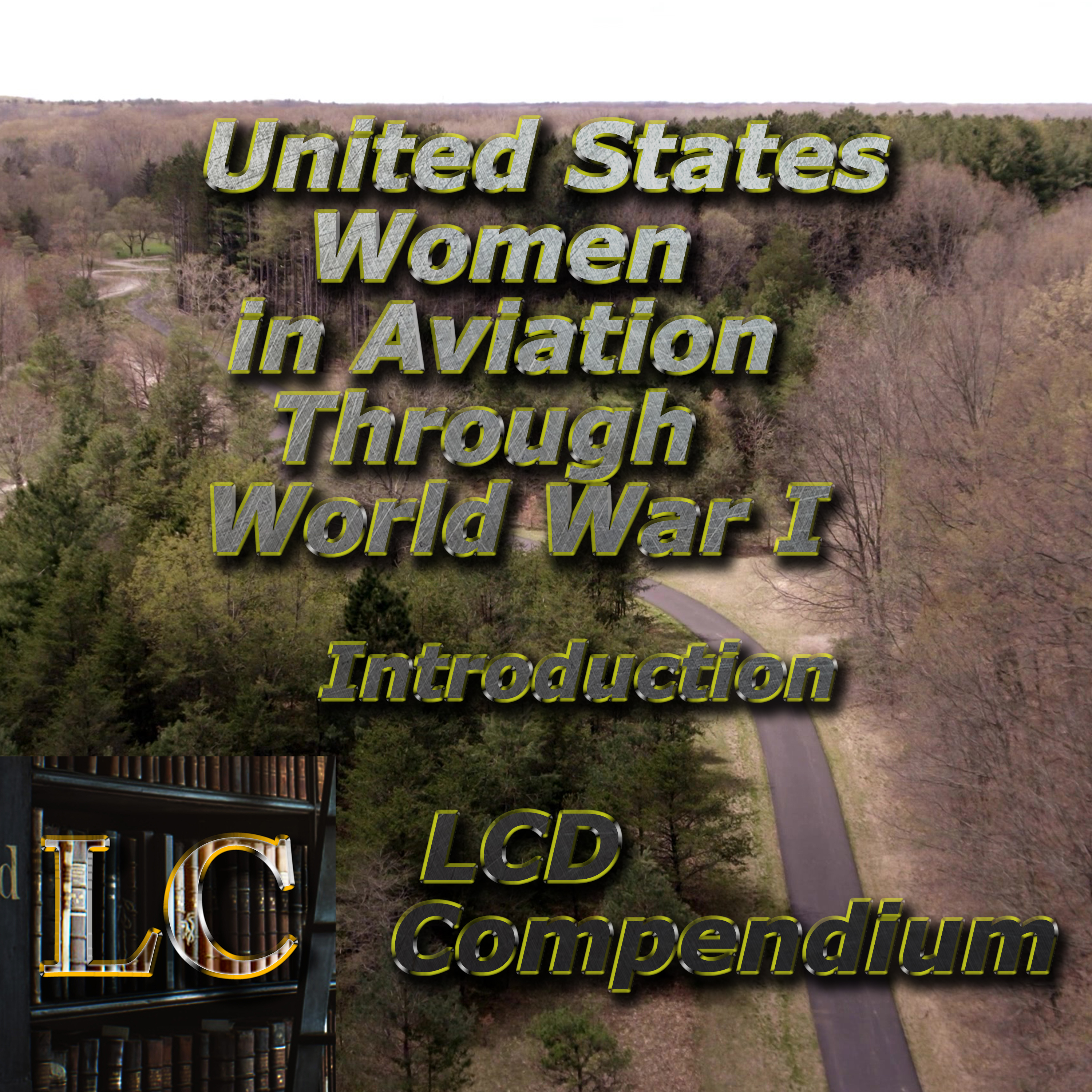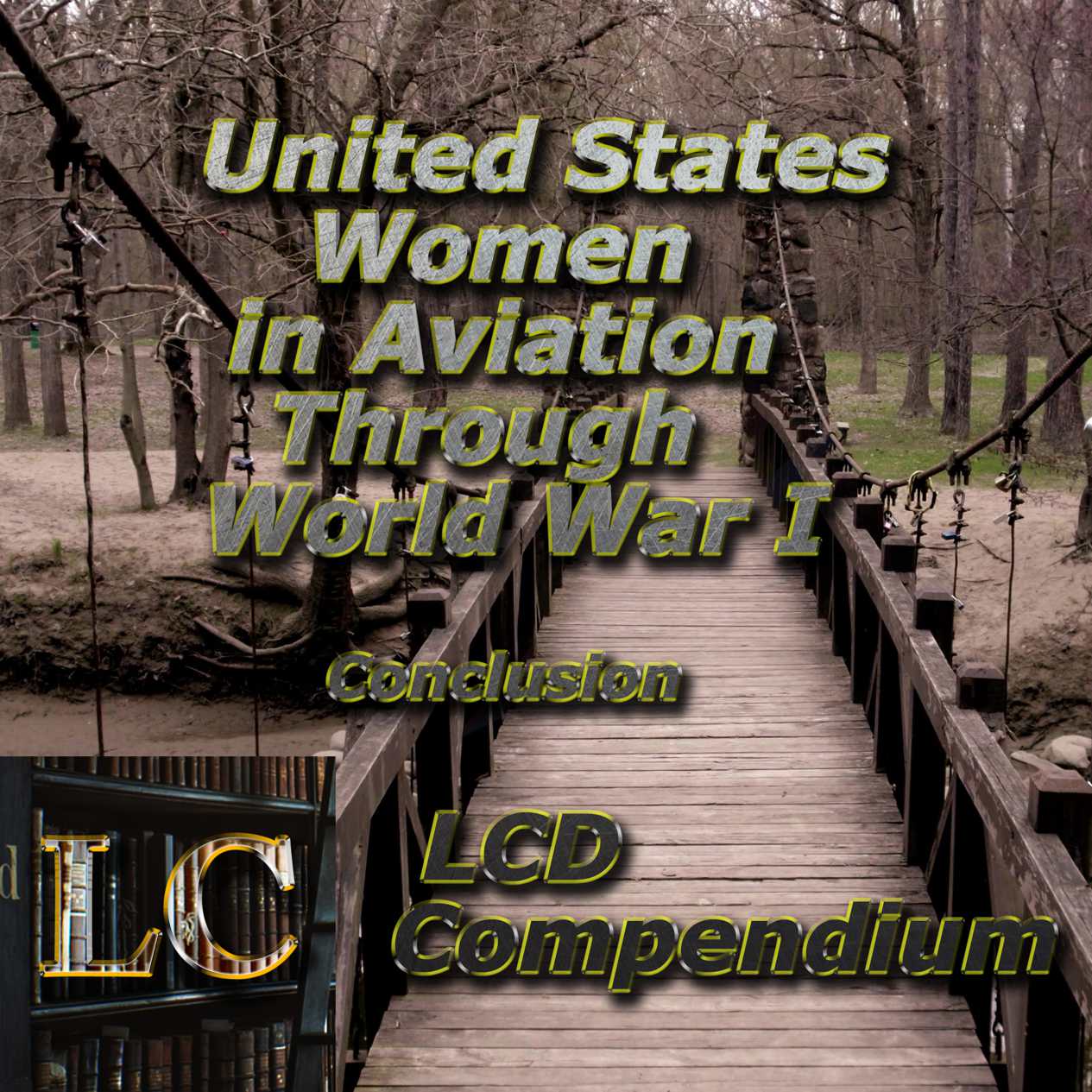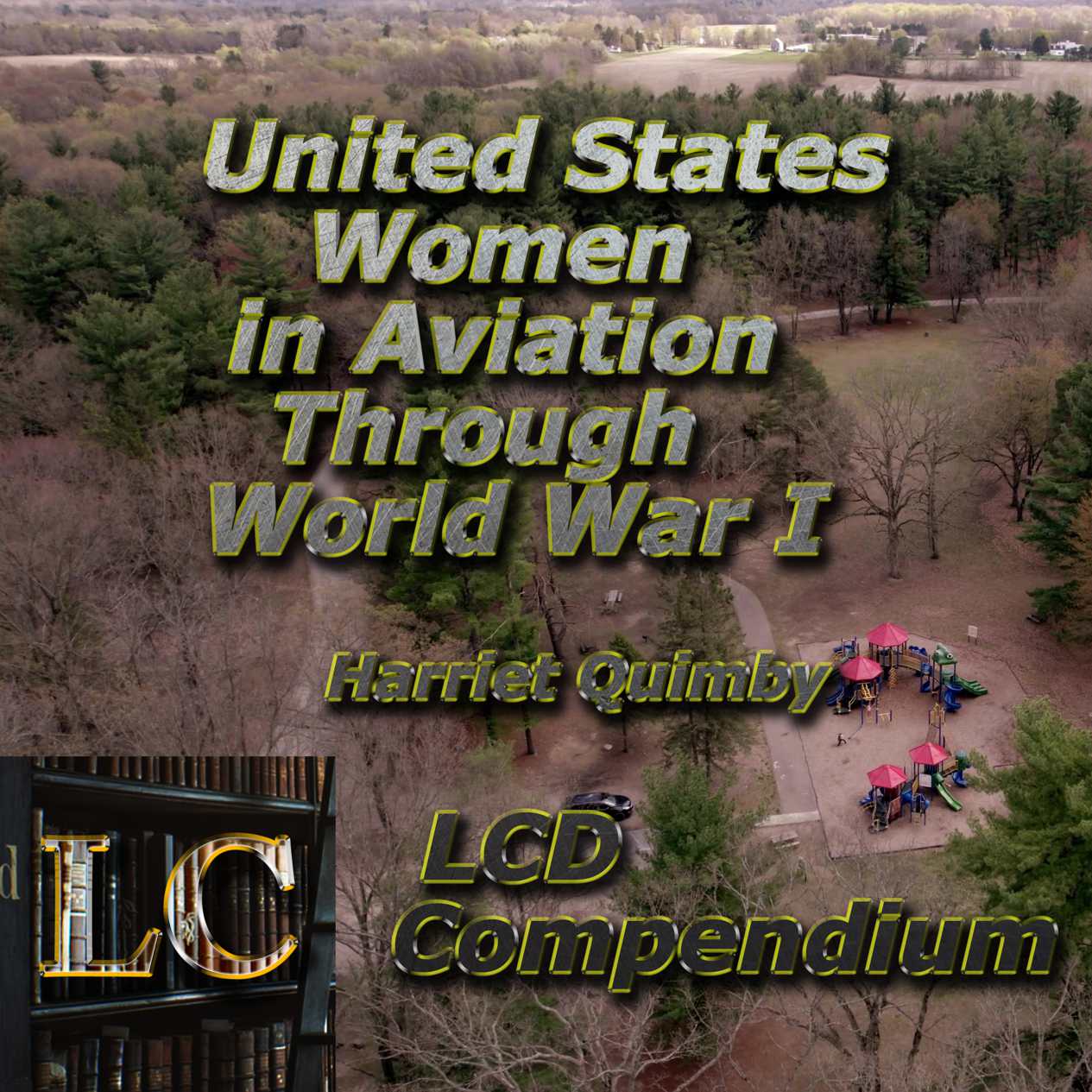Episode Transcript
1
0:00:00,000 --> 0:00:04,000
SERIES PUBLICATIONS OF THE. SMITHSONIAN INSTITUTION
2
0:00:04,000 --> 0:00:08,000
SMITHSONIAN STUDIES IN AIR AND SPACE NUMBER 2
3
0:00:08,000 --> 0:00:13,000
United States Women in Aviation through World War One
4
0:00:13,000 --> 0:00:15,000
by Claudia M Oakes
5
0:00:15,000 --> 0:00:26,000
Aerial Photography from Photations Visit Photations.com and www.PhotationsStore.com for more fine art photography
6
0:00:26,000 --> 0:00:32,000
Help support this series by visiting PhotationsDonations.com
7
0:00:32,000 --> 0:00:34,000
Introduction
8
0:00:34,000 --> 0:00:42,000
'There is the world old controversy that crops up again whenever women attempt to enter a new field
9
0:00:42,000 --> 0:00:58,000
Is woman fitted for this or that work It would seem that a woman’s success in any particular line would prove her fitness for that work, without regard to theories to the contrary' (Law, 1918)
10
0:00:58,000 --> 0:01:08,000
This statement made by the famous aviatrix Ruth Law in 1918 remains pertinent to contemporary issues
11
0:01:08,000 --> 0:01:29,000
More than half a century later, although acceptance of women in aviation in the United States is established, some barriers to full participation still remain The military is now admitting women to pilot training, though principally for cargo aircraft and helicopters
12
0:01:29,000 --> 0:01:31,000
The U S
13
0:01:31,000 --> 0:01:57,000
Navy has a female pilot who flies a combat type aircraft, an LTV A 7 fighter, but she is assigned to a noncombat land based utility squadron The issue of women flying in combat is one facet of the litigation now being pressed in federal courts to open the military services to full participation by women
14
0:01:57,000 --> 0:02:14,000
In the field of commercial aviation, progress is very noticeable According to a survey by Frontier Airlines, as of February 1977 there were 18 women flying for regularly scheduled airlines in the United States
15
0:02:14,000 --> 0:02:25,000
Five of these women were first officers (co pilots), and by the summer of 1977 one had been promoted to captain
16
0:02:25,000 --> 0:02:40,000
These opportunities for women in aviation today did not come about overnight They are based on several decades of struggle, determination, and achievement on the part of many courageous women
17
0:02:40,000 --> 0:02:48,000
The earliest of these activities go back to the very beginning of aviation in the United States
18
0:02:48,000 --> 0:03:09,000
In those early days of the twentieth century, women in this country who wanted to be pilots were abundantly familiar with the general fight of women for acceptance in stereotypically all male pursuits Aviation, however, on a worldwide basis was not traditionally all male
19
0:03:09,000 --> 0:03:17,000
In Europe as early as 1834 there were 22 women who had piloted balloons
20
0:03:17,000 --> 0:03:46,000
As the field of aviation developed into heavier than air craft, it might have been expected that women, having been so active in the lighter than air era, would be just as active in the airplane age Claude Grahame White, a famous early British aviator, was among the many people for whom this conclusion did not logically follow
21
0:03:46,000 --> 0:04:09,000
He confessed that he regretted having taught women to fly because he felt he had pushed them toward an early death He did not doubt their courage, he said, but feared that a woman’s 'innate' lack of self confidence would cause her to panic in an emergency situation and lose control
22
0:04:09,000 --> 0:04:22,000
1 This premise was refuted time and time again, however, as women pilots coolly recovered from perilous situations in the air and landed safely
23
0:04:22,000 --> 0:04:43,000
Sometimes in those early days theories and articles supporting the idea of women as pilots did almost more harm than good In 1911 Prof. Rudolph Hensingmüller of Vienna published a list of reasons why he believed women were better pilots than men were
24
0:04:43,000 --> 0:04:57,000
Some of his reasons, which were regarded as so ludicrous that they were immediately held up to ridicule, were: because she has retained the primitive faculty of seeing with full retina
25
0:04:57,000 --> 0:05:01,000
enforced modesty and flirting have caused this
26
0:05:01,000 --> 0:05:11,000
because she has scattered attention instead of concentration this is invaluable to an aviator who must notice many things at once
27
0:05:11,000 --> 0:05:25,000
because she has the faculty of intuition—that quality of the mind which can take in a number of causes simultaneously and induce a conclusion—an essential in aviation
28
0:05:25,000 --> 0:05:30,000
because her specific gravity is less than man’s
29
0:05:30,000 --> 0:05:37,000
because she needs less oxygen and therefore can better meet the suffocating rush of air
30
0:05:37,000 --> 0:05:41,000
altitude effects her less than it does man
31
0:05:41,000 --> 0:05:55,000
because her sneezes, in man an actual spasm, have been controlled by ages of polite repression, because she feels more quickly warning atmospheric changes
32
0:05:55,000 --> 0:05:57,000
because she loves to speed
33
0:05:57,000 --> 0:06:08,000
2 There were other writers, however, who put forward more convincing articles on the subject of women as pilots
34
0:06:08,000 --> 0:06:18,000
Such prestigious aviation journals as the Rev. . ue Aérienne and Flying were printing articles supporting women in their flying endeavors
35
0:06:18,000 --> 0:06:34,000
Part of the furor over women flying stemmed from the unusual manner in which they had to dress Obviously, the long flowing skirts and large hats then in fashion were impossible for women pilots to wear
36
0:06:34,000 --> 0:06:55,000
Shocking as the idea might be, trousers were the most practical mode of dress Some of the women compromised with convention by making the trousers with rows of buttons on the inside seams so they could convert them to skirts when not in the air
37
0:06:55,000 --> 0:07:22,000
The general flying outfit for a woman consisted of a two piece suit of blouse and wide legged knickers, with high top boots and either an automobile cap or soft fabric helmet with goggles In contrast to most of the outfits which were made of conservative, dark fabric, Harriet Quimby flew in a suit of plum colored satin
38
0:07:22,000 --> 0:07:36,000
Hélène Dutrieu of France caused quite a stir when she admitted to flying corsetless She said it gave her greater freedom of movement and also lessened the chance of injury in case of an accident
39
0:07:36,000 --> 0:07:58,000
In spite of all the publicity the women received, the many accomplishments they achieved, and the records they set proving their worth as pilots, no amount of evidence and persuasion could convince the War Department to allow any of them into the Air Service during World War One
40
0:07:58,000 --> 0:08:17,000
Most of the women lobbied strongly to be allowed to fly for the war effort Their goal was combat flying, but they pleaded with the Air Service to allow them to enlist and to put to use their flying abilities in whatever ways might be of service
41
0:08:17,000 --> 0:08:18,000
Rep
42
0:08:18,000 --> 0:08:41,000
Murray Hulbert supported their efforts and sponsored a bill in Congress to that end There was active support for the measure and its passage appeared possible until Secretary of War Baker flatly stated, 'We don’t want to let down the bars to women in the army' (Hulbert, 1918)
43
0:08:41,000 --> 0:08:43,000
As a result, U S
44
0:08:43,000 --> 0:08:52,000
women were not allowed to take part officially in World War One as pilots 3 But the women flyers did serve
45
0:08:52,000 --> 0:09:08,000
They flew exhibition flights and fund raising flights for the Red Cross and Liberty Loan drives, lent their famous names to the recruiting effort, and even trained future military pilots at private airfields
46
0:09:08,000 --> 0:09:30,000
This study focuses attention on the women who contributed significantly in those early years to shaping the future of aviation There were women test pilots in those pioneer years, women who set altitude and distance records, and women who flew for the sheer joy of it
47
0:09:30,000 --> 0:09:40,000
All of them are examples of what can be accomplished when the desire and the determination to succeed are strong
48
0:09:40,000 --> 0:10:01,000
A majority of the source material used for this publication came from the National Air and Space Museum Library This facility contains an extensive collection of newspaper clippings, magazines, books, photographs, and other material related to the history of aviation
49
0:10:01,000 --> 0:10:11,000
Other sources, which I gratefully acknowledge, are: Bettmann Archive, 136 E 57th St
50
0:10:11,000 --> 0:10:12,000
, New York, New York 10022 the Detroit Public Library
51
0:10:12,000 --> 0:10:18,000
Rare Birds, Inc , 791 Nisqually Dr. .
52
0:10:18,000 --> 0:10:19,000
, Sunnyvale, California 94087 The St
53
0:10:19,000 --> 0:10:23,000
Petersburg Times and Neta Snook Southern
54
0:10:23,000 --> 0:10:38,000
Although the term 'aviatrix' is no longer popular among women pilots, I have used it throughout this book to retain a flavor of the era and an aura of the personalities about which I write
55
0:10:38,000 --> 0:11:07,000
During my research I came to feel close to these women, to sense their frustrations in trying to find aviation schools which would accept them, people who would trust them with their aircraft, and then, as acceptance of them as pilots was getting stronger and stronger, to have all they had worked toward stymied by not being allowed to fly in World War One
56
0:11:07,000 --> 0:11:20,000
Despite all the obstacles, women in steady numbers did become pilots What the aviation world would do about them, whether it would use their skills or try to ignore them, remained to be seen
57
0:11:20,000 --> 0:11:38,000
The women who flew after World War One had their problems and barriers, too, but they could look back on their predecessors’ struggles and take heart that acceptance of their flying abilities was possible These second generation U
58
0:11:38,000 --> 0:11:43,000
S women pilots started from the base built by those before them
59
0:11:43,000 --> 0:11:55,000
People had become a bit more reconciled to the idea of women flying airplanes But for those very early women, there was literally nowhere to go but up



